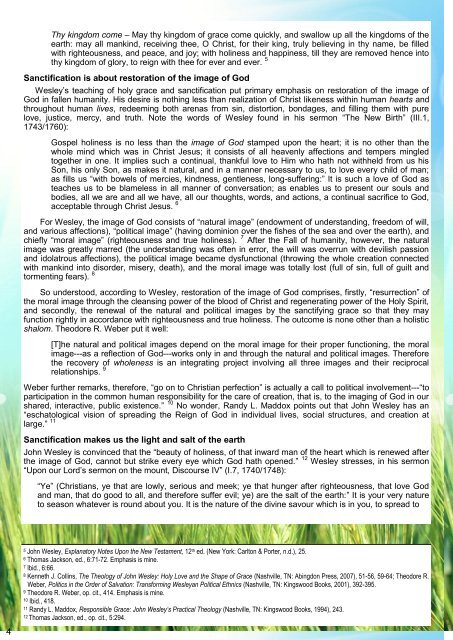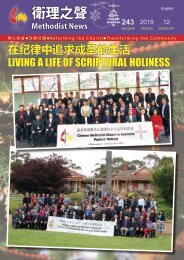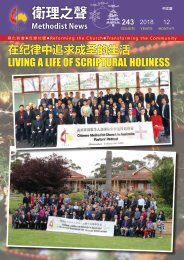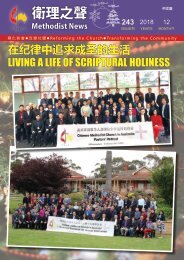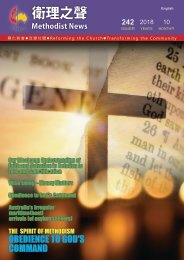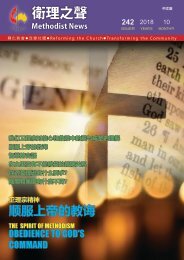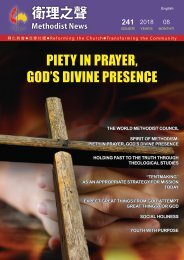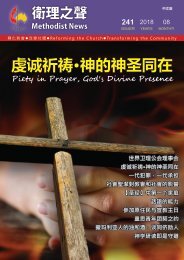227e
Methodist News 227 English Edition for Apr 2016 - A publication by the Chinese Methodist Church in Australia
Methodist News 227 English Edition for Apr 2016 - A publication by the Chinese Methodist Church in Australia
You also want an ePaper? Increase the reach of your titles
YUMPU automatically turns print PDFs into web optimized ePapers that Google loves.
Thy kingdom come – May thy kingdom of grace come quickly, and swallow up all the kingdoms of the<br />
earth: may all mankind, receiving thee, O Christ, for their king, truly believing in thy name, be filled<br />
with righteousness, and peace, and joy; with holiness and happiness, till they are removed hence into<br />
thy kingdom of glory, to reign with thee for ever and ever. 5<br />
Sanctification is about restoration of the image of God<br />
Wesley’s teaching of holy grace and sanctification put primary emphasis on restoration of the image of<br />
God in fallen humanity. His desire is nothing less than realization of Christ likeness within human hearts and<br />
throughout human lives, redeeming both arenas from sin, distortion, bondages, and filling them with pure<br />
love, justice, mercy, and truth. Note the words of Wesley found in his sermon “The New Birth” (III.1,<br />
1743/1760):<br />
Gospel holiness is no less than the image of God stamped upon the heart; it is no other than the<br />
whole mind which was in Christ Jesus; it consists of all heavenly affections and tempers mingled<br />
together in one. It implies such a continual, thankful love to Him who hath not withheld from us his<br />
Son, his only Son, as makes it natural, and in a manner necessary to us, to love every child of man;<br />
as fills us “with bowels of mercies, kindness, gentleness, long-suffering:” It is such a love of God as<br />
teaches us to be blameless in all manner of conversation; as enables us to present our souls and<br />
bodies, all we are and all we have, all our thoughts, words, and actions, a continual sacrifice to God,<br />
acceptable through Christ Jesus. 6<br />
For Wesley, the image of God consists of “natural image” (endowment of understanding, freedom of will,<br />
and various affections), “political image” (having dominion over the fishes of the sea and over the earth), and<br />
chiefly “moral image” (righteousness and true holiness). 7 After the Fall of humanity, however, the natural<br />
image was greatly marred (the understanding was often in error, the will was overrun with devilish passion<br />
and idolatrous affections), the political image became dysfunctional (throwing the whole creation connected<br />
with mankind into disorder, misery, death), and the moral image was totally lost (full of sin, full of guilt and<br />
tormenting fears). 8<br />
So understood, according to Wesley, restoration of the image of God comprises, firstly, “resurrection” of<br />
the moral image through the cleansing power of the blood of Christ and regenerating power of the Holy Spirit,<br />
and secondly, the renewal of the natural and political images by the sanctifying grace so that they may<br />
function rightly in accordance with righteousness and true holiness. The outcome is none other than a holistic<br />
shalom. Theodore R. Weber put it well:<br />
[T]he natural and political images depend on the moral image for their proper functioning, the moral<br />
image---as a reflection of God---works only in and through the natural and political images. Therefore<br />
the recovery of wholeness is an integrating project involving all three images and their reciprocal<br />
relationships. 9<br />
Weber further remarks, therefore, “go on to Christian perfection” is actually a call to political involvement---“to<br />
participation in the common human responsibility for the care of creation, that is, to the imaging of God in our<br />
shared, interactive, public existence.” 10 No wonder, Randy L. Maddox points out that John Wesley has an<br />
“eschatological vision of spreading the Reign of God in individual lives, social structures, and creation at<br />
large.” 11<br />
Sanctification makes us the light and salt of the earth<br />
John Wesley is convinced that the “beauty of holiness, of that inward man of the heart which is renewed after<br />
the image of God, cannot but strike every eye which God hath opened.” 12 Wesley stresses, in his sermon<br />
“Upon our Lord’s sermon on the mount, Discourse IV” (I.7, 1740/1748):<br />
“Ye” (Christians, ye that are lowly, serious and meek; ye that hunger after righteousness, that love God<br />
and man, that do good to all, and therefore suffer evil; ye) are the salt of the earth:” It is your very nature<br />
to season whatever is round about you. It is the nature of the divine savour which is in you, to spread to<br />
5 John Wesley, Explanatory Notes Upon the New Testament, 12 th ed. (New York: Carlton & Porter, n.d.), 25.<br />
6 Thomas Jackson, ed., 6:71-72. Emphasis is mine.<br />
7 Ibid., 6:66.<br />
8 Kenneth J. Collins, The Theology of John Wesley: Holy Love and the Shape of Grace (Nashville, TN: Abingdon Press, 2007), 51-56, 59-64; Theodore R.<br />
Weber, Politics in the Order of Salvation: Transforming Wesleyan Political Ethnics (Nashville, TN: Kingswood Books, 2001), 392-395.<br />
9 Theodore R. Weber, op. cit., 414. Emphasis is mine.<br />
10 Ibid., 418.<br />
11 Randy L. Maddox, Responsible Grace: John Wesley’s Practical Theology (Nashville, TN: Kingswood Books, 1994), 243.<br />
12 Thomas Jackson, ed., op. cit., 5:294.<br />
4


